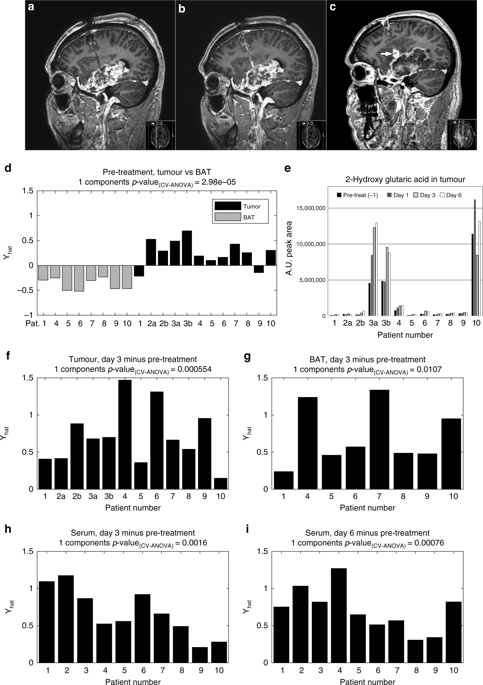当前位置:
X-MOL 学术
›
Br. J. Cancer
›
论文详情
Our official English website, www.x-mol.net, welcomes your
feedback! (Note: you will need to create a separate account there.)
Metabolic response patterns in brain microdialysis fluids and serum during interstitial cisplatin treatment of high-grade glioma.
British Journal of Cancer ( IF 6.4 ) Pub Date : 2019-12-10 , DOI: 10.1038/s41416-019-0652-x Benny Björkblom 1 , Pär Jonsson 1 , Pedram Tabatabaei 2 , Per Bergström 3 , Mikael Johansson 3 , Thomas Asklund 3 , A Tommy Bergenheim 2 , Henrik Antti 1
British Journal of Cancer ( IF 6.4 ) Pub Date : 2019-12-10 , DOI: 10.1038/s41416-019-0652-x Benny Björkblom 1 , Pär Jonsson 1 , Pedram Tabatabaei 2 , Per Bergström 3 , Mikael Johansson 3 , Thomas Asklund 3 , A Tommy Bergenheim 2 , Henrik Antti 1
Affiliation

|
BACKGROUND
High-grade gliomas are associated with poor prognosis. Tumour heterogeneity and invasiveness create challenges for effective treatment and use of systemically administrated drugs. Furthermore, lack of functional predictive response-assays based on drug efficacy complicates evaluation of early treatment responses.
METHODS
We used microdialysis to deliver cisplatin into the tumour and to monitor levels of metabolic compounds present in the tumour and non-malignant brain tissue adjacent to tumour, before and during treatment. In parallel, we collected serum samples and used multivariate statistics to analyse the metabolic effects.
RESULTS
We found distinct metabolic patterns in the extracellular fluids from tumour compared to non-malignant brain tissue, including high concentrations of a wide range of amino acids, amino acid derivatives and reduced levels of monosaccharides and purine nucleosides. We found that locoregional cisplatin delivery had a strong metabolic effect at the tumour site, resulting in substantial release of glutamic acid, phosphate, and spermidine and a reduction of cysteine levels. In addition, patients with long-time survival displayed different treatment response patterns in both tumour and serum. Longer survival was associated with low tumour levels of lactic acid, glyceric acid, ketoses, creatinine and cysteine. Patients with longer survival displayed lower serum levels of ketohexoses, fatty acid methyl esters, glycerol-3-phosphate and alpha-tocopherol, while elevated phosphate levels were seen in both tumour and serum during treatment.
CONCLUSION
We highlight distinct metabolic patterns associated with high-grade tumour metabolism, and responses to cytotoxic cisplatin treatment.
中文翻译:

间质顺铂治疗高级别胶质瘤期间脑微透析液和血清的代谢反应模式。
背景高级别胶质瘤与预后不良有关。肿瘤异质性和侵袭性为有效治疗和使用全身给药药物带来挑战。此外,缺乏基于药物功效的功能性预测反应分析使早期治疗反应的评估变得复杂。方法 我们使用微透析将顺铂输送到肿瘤中,并在治疗前和治疗期间监测肿瘤和与肿瘤相邻的非恶性脑组织中存在的代谢化合物水平。同时,我们收集了血清样本并使用多变量统计数据来分析代谢效应。结果 与非恶性脑组织相比,我们发现肿瘤细胞外液中的代谢模式不同,包括高浓度的多种氨基酸,氨基酸衍生物和降低的单糖和嘌呤核苷水平。我们发现,局部顺铂给药在肿瘤部位具有很强的代谢作用,导致谷氨酸、磷酸盐和亚精胺大量释放并降低半胱氨酸水平。此外,长期存活的患者在肿瘤和血清中表现出不同的治疗反应模式。较长的生存期与乳酸、甘油酸、酮糖、肌酐和半胱氨酸的低肿瘤水平相关。生存期较长的患者血清中的己酮糖、脂肪酸甲酯、3-磷酸甘油和α-生育酚水平较低,而在治疗期间,肿瘤和血清中的磷酸盐水平均升高。
更新日期:2019-12-11
中文翻译:

间质顺铂治疗高级别胶质瘤期间脑微透析液和血清的代谢反应模式。
背景高级别胶质瘤与预后不良有关。肿瘤异质性和侵袭性为有效治疗和使用全身给药药物带来挑战。此外,缺乏基于药物功效的功能性预测反应分析使早期治疗反应的评估变得复杂。方法 我们使用微透析将顺铂输送到肿瘤中,并在治疗前和治疗期间监测肿瘤和与肿瘤相邻的非恶性脑组织中存在的代谢化合物水平。同时,我们收集了血清样本并使用多变量统计数据来分析代谢效应。结果 与非恶性脑组织相比,我们发现肿瘤细胞外液中的代谢模式不同,包括高浓度的多种氨基酸,氨基酸衍生物和降低的单糖和嘌呤核苷水平。我们发现,局部顺铂给药在肿瘤部位具有很强的代谢作用,导致谷氨酸、磷酸盐和亚精胺大量释放并降低半胱氨酸水平。此外,长期存活的患者在肿瘤和血清中表现出不同的治疗反应模式。较长的生存期与乳酸、甘油酸、酮糖、肌酐和半胱氨酸的低肿瘤水平相关。生存期较长的患者血清中的己酮糖、脂肪酸甲酯、3-磷酸甘油和α-生育酚水平较低,而在治疗期间,肿瘤和血清中的磷酸盐水平均升高。











































 京公网安备 11010802027423号
京公网安备 11010802027423号